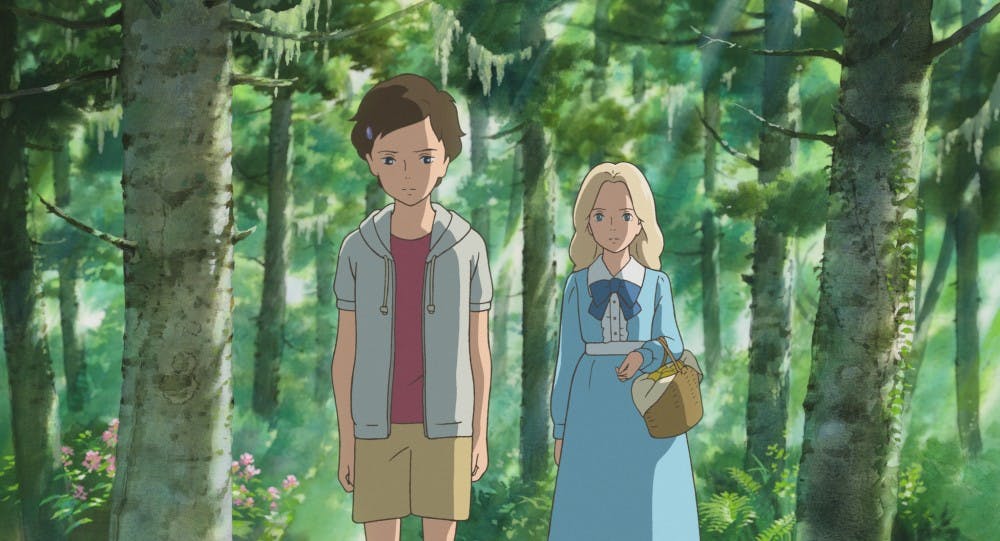Enchanting and graceful, Studio Ghibli’s “When Marnie Was There” takes place in the lush, rural seaside town of Kushiro, Japan. The film, based on the British novel “When Marnie Was There” by Joan G. Robinson, follows 12-year-old Anna Sasaski, voiced by Sara Takatsuki (“GTO: Great Teacher Onizuka”). Early on in the film, Anna suffers a stress-induced asthma attack, causing Anna’s foster mother Yoriko, voiced by Nanako Matsushima (“Ringu”), to send her away to Kushiro to live with her aunt and uncle, the Oiwas. Their loud, boisterous and kind nature encourages Anna, who considered herself quiet and shy, to explore her surroundings and make new friends. In a heartwarming and charming tale about loneliness, friendship and the value of family, the audience joins Anna on her journey of self-discovery.
The Marsh House, an abandoned mansion overgrown with shrubbery that overlooks a marsh, immediately entrances Anna when she arrives Each evening at high tide, Anna dreams she visits the mansion. During her visits, she finds the Marsh House inhabited by a mysterious young blonde girl in old-fashioned dress. Intrigued, she returns to the house again and again both in real life and in her dreams, and at times the line between the two appears blurred. One evening, Anna meets Marnie, voiced by Kasumi Arimura (“Amachan”), and the two quickly become friends. Their quick budding relationship makes the audience believe the two characters already knew each other.
Anna and Marnie’s relationship seems unique, especially since Anna comes from a modest background and Marnie grew up in a ritzy, lavish environment. Despite their different upbringings, the two characters have a lot in common. However, the audience soon realizes that their conversations only exist in Anna’s imagination. This eerie aspect causes the audience to question the connection between Anna and Marnie. At the end of the film, the director reveals a shocking element of Anna and Marnie’s, an aspect that allows the audience to finally understand why the two seemed to know each other so well when they first met.
Hiromasa Yonebayashi, Ghibli’s youngest director to date, directs the film with a melancholy grace and subtle supernatural elements that distinguish “When Marnie Was There” from the studio’s other works. Yonebayashi’s artistic style and creative design make the film relatable and believable. Studio Ghibli’s co-founder Hayao Miyazaki has long been a fan of “When Marnie Was There,” and the book made it to #18 on his list of 50 books he recommended to children in 2011. This was perhaps one of the reasons Studio Ghibli chose to adapt the book, and since Miyazaki has since retired, the film serves as an ethereal send-off to the talented director and animator.
The film suffers from two dimensional secondary characters, in particular the Oiwas, Anna’s foster parents and an artist named Hisako. Anna’s stiff and nearly non-existent relationship with her aunt and uncle cause the audience to question their purpose in the film. Near the end of the film, Anna resolves her feelings of hatred toward her foster parents back home, a scene meant to depict how she’s matured during her stay with her relatives. However, the creators of the film didn’t develop her foster parents strong enough for this moment to be pivotal. Hisako, voiced by Hitomi Kuroki (“Lost Paradise”), reveals Marnie’s life story and secrets through conversations with Anna, but this serves as her only function in the film.
Despite its weak secondary characters, the film boasts great strengths. The real star of the film is Marnie, whose grace, beauty and kindness make her impossible to dislike. The beautiful animation and the ethereal quality of the scenes make viewers feel as if they can freeze the film at any point and have something worth framing. Although it’s an animated film, “When Marnie Was There” contains mature scenes that depict loneliness and loss, making it a film clearly geared toward adults.
Grade: A
“When Marnie Was There” (PG, 103 min) is now playing at Landmark’s E Street Cinema.





